The
Flintstone Rocket
|
|
Home
|
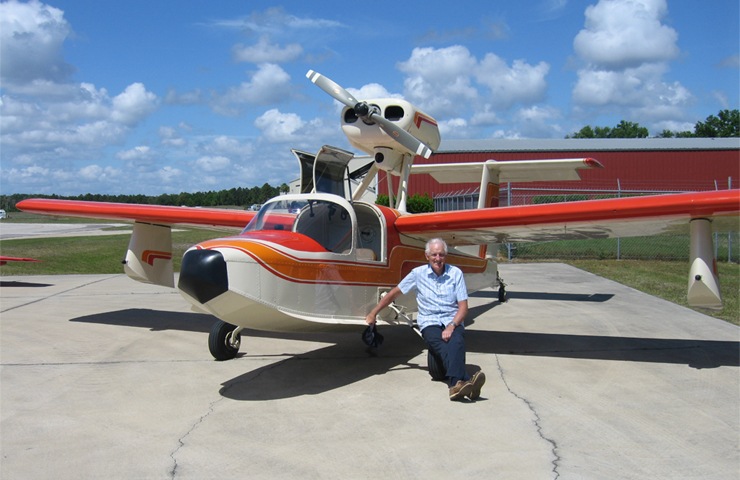
It was all worth it
in the end!
Tom Beck having a rest at Flagler Airport, Florida.
I had just been scared to death by the darn thing. Unknown to me, my
passenger had
inadvertently wound full bow trim on for the landing. We exited sharply
to the right!
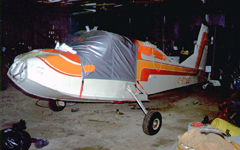
C-GDQD |
|
Only partly awake, in that
zone where nothing is certain other than perhaps that it was
after all only a nightmare. With my disconnected head floating
freely above a bank of white cloud and trying to make sense of
a barn stuffed full of junk that may once have been an
aircraft. Well, that's a relief. I can get back to normal now!
I slowly open my eyes. I am
in a single bed, surrounded by white sheets, blankets and
banks of machines and pipes. Sitting next to me and holding my
unfeeling hand is a small Indonesian male nurse wearing a
worried expression. Seeing that my eyes are open he says,
"The doctor is on his way." Great!
Just what the hell is going
on? I remember being wheeled on a very narrow stretcher into a
pre-op room that resembled a corridor and seeing an
anaesthetist. I also recall the specialist leaning against the
wall in his overalls smoking a cigar. He asks, in a broad
Glaswegian accent, "How are you doing then?" I reply
that I am as nervous as a kitten and seriously considering
doing a runner. He laughs and says that I wouldn't get far as
the hospital needs my money and that they employ guards to
return any runaways.
It's starting to make sense.
The specialist was Derek McMinn and I was being wheeled in for
the first of two hip resurfacing operations. What on earth did
they knock me out with?
I still can't feel anything!
|
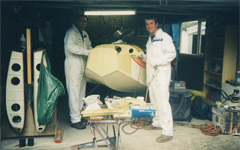
Peter
& Marc
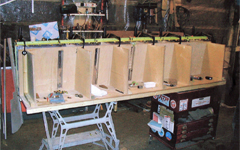
Jig
for tailplane
rebuild
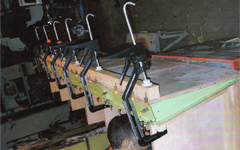
Jig
for elevator
rebuild |
|
So what was all that stuff
in a barn? I recall bringing a flight into Manchester and
driving to Pontefract for a few hours of sleep. While asleep,
my brother Bob, Bob McLean, Terry Potter and George McLean had
collected my current project from a stone barn high up in the
Pennine hills and parked the trailer full of bent bits outside
my bedroom. When up and about, my friend and host, Peter Scott
- who had also loaned me his Ford Explorer, helped me hook up
the trailer and off I set for Sussex, where friends Martyn,
Matt and Bob Smith helped me unload. As each part came off the
trailer my heart sank as more and more serious damage became
apparent.
A quick sleep was followed
by the return drive to Halifax, a taxi to Doncaster, a train
back to Sussex and another short sleep followed by a drive to
Birmingham for the operation.
Why do I let myself get into
these situations? Will I never learn?
It all started in late
summer of 2002 because I thought that, in Florida, I really
needed an aircraft which could land on water as well as on
land. Peter Scott had said that he knew of such an aircraft,
which had been written off 10 years earlier and that a friend
of his, Rodney Heaton, now owned and had the parts stored in
an old stone barn.
Well! Being a sucker for old
damaged aircraft, I was persuaded to go and have a look. It
was bad, worse in fact than anything that I had ever seen!
"No, definitely not. Thank you Rodney but no, It's far
too big a job for me." Rodney replied in his broad
Yorkshire accent "I'll tell thee whot lad, mek me a silly
offer. Ah knows that thee can fix it up and when th'as
finished, I can come to Florida and fly it with thee". I
was hooked. We did the deal and I broke one of my cardinal
rules: 'Never buy a type you haven't flown'.
So how, I can hear you
thinking, did this 1971 relic end up as a collection of bent
bits in Yorkshire? For anoraks like myself, it is a seaplane,
actually an amphibious flying boat.
(Defined as a seaplane where
the fuselage provides the buoyancy.)
Serial number 15, Thurston
Teal was constructed at Sanford, Maine prior to being flown to
Canada, where it flew until 1992 as C-GDQD. A UK resident
bought the aircraft, had its wings and tailplane extended and
employed Keith Sissons to fly it to Oxenhope airfield in
Yorkshire. Keith, who I have never met, is an experienced
seaplane pilot and is obviously made of different stuff to me!
After more modifications which allowed the aircraft to be
flown over the Atlantic at weights of 400lb or 20% heaver than
normal, Keith flew from the Toronto area via Goose Bay,
Narsarsuak, Reykavik, Hornafjordur, Glasgow and finally to
Huddersfield. Total flight time of 44:36 hrs, with one leg of
10:25 and one of 9:25. It's hard to imagine the skill, ability
and courage required to ferry an aircraft of this type across
the Atlantic. The journey took 12 days and was a fantastic
achievement. That the aircraft still flies today, is a tribute
to Keith. I take my hat off to him.
Sadly, the aircraft flew on
only 4 days from Oxenhope, during which time it was flown to
Ireland where landing on water is allowed, this not being the
case for most of England.
Back at Oxenhope, the
aircraft was left overnight without being tied down and was
blown over in a strong wind. It rolled to the right, smashing
the nose, right wing float and wing tip. At this point it was
blown over onto its back, forcing the engine and its mount
into the cockpit, tearing the 'A' frame pickups out of the
main spar and completely trashing the stabilizer, elevator,
fin and rudder.
After Rodney assumed
ownership, he stored the now disassembled parts in his barn
and for years tracked down and bought many of the parts which
would eventually be required to repair and reassemble the
aircraft. However, the task of finding an engineer with the
time, skill and inclination to complete the rebuild proved to
be more problematic.
|
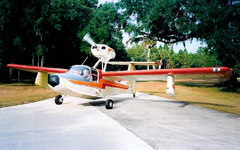
Engine
run
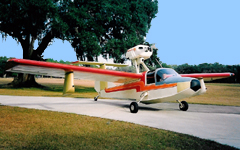
Engine
run |
|
Although provisionally
allocated the UK registration of G-TEAL, the aircraft was
written off before it could be transferred from the Canadian
register. Time went by and even the Canadian registration was
cancelled.
Once let out of hospital and
able to move around again, I could use my 3 months off work to
plan and organize an effective repair scheme. Although I have
been an aircraft engineer all my working life, I am what is
called in the trade, a 'fairy' or 'sparks' (i.e.
avionics/electrics/instruments) and my skill at repairing
metal stops at pop riveting!
Fortunately for me, I know a
man who does know about it!
When able to drive again, I
loaded all the seriously bent bits into a white van, drove to
Chessington and spread them all over the grass for Marc Anstey
to look at. Marc had every reason to say "no way, Josť -
forget it" but he didn't! He calmly assessed it all,
decided what could be repaired and what had to be built from
scratch and wandered off to his workshop clutching armfuls of
bent tin.
To this day I don't know how
Marc and his friend Peter found the time to repair the
aircraft. Much of the detailed work was done at Chessington
and the rest in my garage at home. Not only was the standard
of workmanship of the highest order but so was all the
paperwork. The photographic record was a work of art in
itself. I and S/N 15 will be forever in your debt, Marc. You
did a great job.
With the help of some
friends in Sussex, we loaded the parts into a container for
shipment to Florida where I carried out the final assembly,
painting and all the required paperwork to put the aircraft
back onto the FAA register. I gave up counting my labor when
it reached 1,000 hours and I doubt that without the timely
help of John Snead, my neighbor in Florida who is also an A
& P mechanic and Inspector as well as Marc and Graham
Rowley, I would still be trying to finish the job.
In the meantime, now 60, I
had retired from the day job in 2003 and had revisited my
cigar-smoking surgeon to have the second hip done. While still
on crutches, I was unable to resist the offer of another
flying job and spent the next three years flying to exotic
places like Basra, Baku, Amritsar and Accra, seemingly always
at night. It might not have been glamorous but it did give me
the wherewithal to complete the Teal and the hangar in which
to house it.
The day finally arrived,
Easter Sunday 2005, when we were able to pull the aircraft out
of the hangar and run the engine. With Marc and John watching,
I checked the various systems in the as yet unfinished
cockpit. "Give it a bit more power," shouted John.
As I did so, even though we were chocked, the aircraft moved
forward a couple of feet and sank onto the grass. The look on
my face must have said it all! John and Marc were doubled up
and helpless with laughter. In my rush to get the ground run
completed, I hadn't fitted the small panel which provided the
mechanical lock for the undercarriage.
This allowed the aircraft to
rotate around the gear and to settle harmlessly on its hull.
As the engine and propeller are mounted well above the wing,
no damage was done, although it took me a while to assimilate
all that!
|
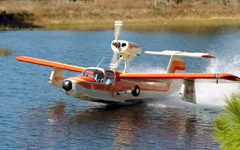
Back
on water!
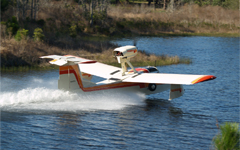
|
|
I had been warned by people
who had flown the Teal in the 70's that its handling could be
tricky but I had been unable to find any write-up or notes
that gave anything other than glowing reports. Well, what can
I say? It is as tricky to operate and fly as anything that I
have ever come across. It can be both sensitive and vicious,
and has some of the worst characteristics of both a tail
dragger and tricycle combined. Or in Peter Scott's immortal
words, "It's a little bugger." Having said that,
it's the same to everyone, it's built like a tank and if
operated well within the capabilities of both the pilot and
aircraft, it's damn clever and a hell of a lot of fun,
especially when on the water.
Strangely, I have been
unable to persuade either John or Marc to fly with me in the
Teal.
They always claim to be much
too busy or say perhaps another time before they disappear out
of sight! Some of my American friends claim that the Teal is a
better boat than an aircraft and because it's so heavy, slow
and underpowered have given it the nickname of the Flintstone
Rocket.
Rodney has been over to
Florida a couple of times and we have flown the Teal together.
He doesn't seem too
enamoured with the handling, and on the last occasion he
remarked, " Aye lad, I'm rite pleased I sold you the
bloody thing. In fact it's sa bad I 'ave bin thinking o'
giving thee a discount." Being Yorkshire, born and bred,
thinking was as far as it got.
The help and enthusiasm of
many people helped turn an idea into reality and it just goes
to show that nightmares can contain the stuff of dreams.
Tom Beck
February 2011.
|
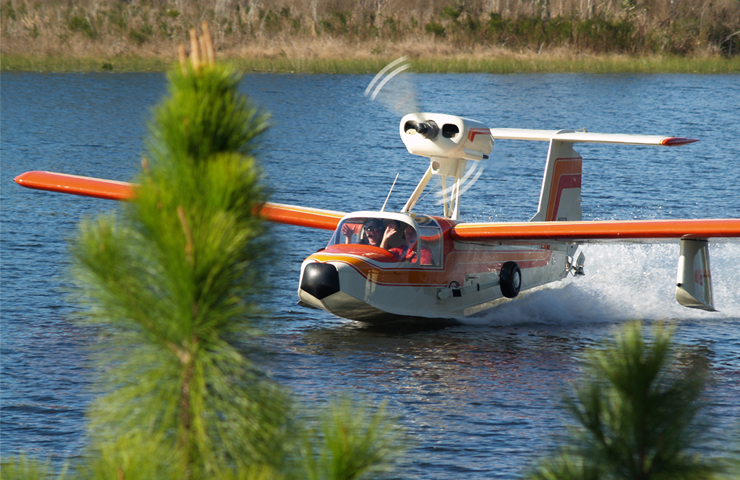
Step taxiing at 45
kts on the lake at Eagles Nest, Florida.
The water rudder is up and gear retracted. It's several knots slower in
the cruise with with
the gear retracted. It's quite hard to balance the aircraft on the tip
of the hull's step.
|
Home
|
|
Updated: 2013-05-22
|

|
© 2013 Steinar Saevdal
|
|